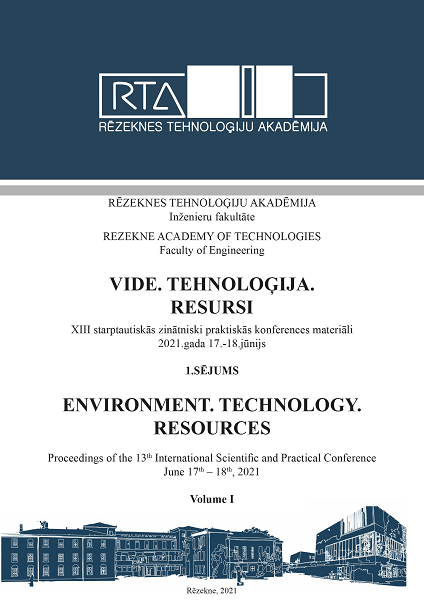MODELLING THE HORIZONTAL VELOCITY FIELD OF THE NIZHNE-KANSK MASSIF ACCORDING TO GNSS OBSERVATIONS
DOI:
https://doi.org/10.17770/etr2021vol1.6545Keywords:
GNSS, modern crustal movements, horizontal velocity, modelling field, Nizhne-Kansk massif, Yenisei Ridge, radioactive wasteAbstract
Within the boundaries of the Nizhne-Kansk granite-gneiss massif, which directly borders on the Atamanovskiy branch of the Yenisei Ridge, the building of an underground research laboratory for validating the safety of disposal of high-level radioactive waste began in 2019. In 2010, researchers of the Mining and Chemical Combine at Zheleznogorsk and the Geophysical Center, Russian Academy of Sciences, organized a satellite geodetic network within the boundaries of the Nizhne-Kansk massif; this network included 30 GNSS stations intended for observations of modern crustal movements.
The purpose of this study is to determine vectors and simulate the field of horizontal modern crustal movements from measurements made in 2010 - 2019. The tasks included: creating a catalogue of displacement data; calculating and estimating horizontal velocities of modern crustal movements, modelling the horizontal velocity field using artificial neural networks, developing a kinematic model of the area and comparing it with geological survey data.
As a result, the resulting model was found to be in good agreement with the results of structural-geological and geodynamic studies in the area. The rate of convergence between the Siberian Platform and the West Siberian Plate in the interaction zone of the southern part of the Yenisei Ridge can be estimated as 2-4 mm/year. The movements of the selected area are due to sublatitudinal compression along an azimuth of 100-110 degrees. Within the selected tectonic blocks relatively low rates of modern horizontal movements of the earth's crust were obtained, which confirms the stable geodynamic regime of the structural block hosting the underground research laboratory. Thus, the results of the work demonstrate the possibility of disposal of high-level radioactive waste in the selected structural block.
Downloads
References
Dorofeev A.N., Bolshov L. A., Linge I. I., Utkin S. S., Saveleva E. A. Strategic Master Plan for R&D Demonstrating the Safety of Construction, Operation and Closure of a Deep Geological Disposal Facility for Radioactive Waste // Radioactive Waste. 2017. № 1. p. 32-41. (In Russian).
Kaftan V.I., Gvishiani A.D., Morozov V.N., Tatarinov V.N. Methods and results of determination of movements and deformations of the Earth’s crust according to GNSS data at the Nizhne-Kansk geodynamic test network in the area of radioactive waste disposal // Sovremennye Problemy Distantsionnogo Zondirovaniya Zemli iz Kosmosa. 2019. №1. p. 83-94. DOI: 10.21046/2070-7401-2019-16-83-94.
Tatarinov V.N., Morozov V.N., Kaftan V.I., Manevich A.I. Modern geodynamics of the southern of the Yenisei ridge derived from the results of satellite observations // Geophysical research. 2018. Vol.19. No.4. p. 65-79. DOI: 10.21455/gr2018.4-5.
Gvishiani A.D., Tatarinov V.N., Kaftan V.I., Manevich A.I., Dzeboev B.A., Losev I.V. The velocities of modern horizontal movements of Earth crust in the South sector of Yenisei ridge according to GNSS observations // Doklady Earth Sciences. 2020. Vol. 493. №1. p. 73-77. DOI: 10.1134/S1028334X20070077.
Wu J., Tang С., Chen Y. Effect of triangle shape factor on precision of crustal deformation calculated // Journal of Geodesy and Geodynamics. 2003. Vol. 23(3). p. 26-30. (in Chinese).
Dokukin P.A., Kaftan V.I., Krasnoperov R.I. Influence of triangle shape in geodetic network on the results of definition of Earth surface deformations // Izvestiya vuzov. Geodeziya i aerofotosemka = Proceedings of universities. Geodesy and aerophotography. 2010. No. 5. p. 6–11.
Markovich K.I. Influence of the configuration of final elements on the accuracy of determination of the components of deformation // Vestnik SSUGT (Siberian State University of Geosystems and Technologies). 2019. Vol. 24. №3. p. 37-51. https://doi.org/10.33764/2411-1759-2019-24-3-37-51. [in Russian].
Lobatskaya R.M. Neotectonic fault-block structure of junction of Siberian platform and West Siberian plate // Russian Geology and Geophysics. 2005. Т.46. №2. p. 141-150.
Kolmogorova P.P., Kolmogorov V.G. Modern vertical movements of the Earth's crust of the Yenisei ridge // Russian Geology and Geophysics. 2004. Т.45. №4. p. 455-466.


